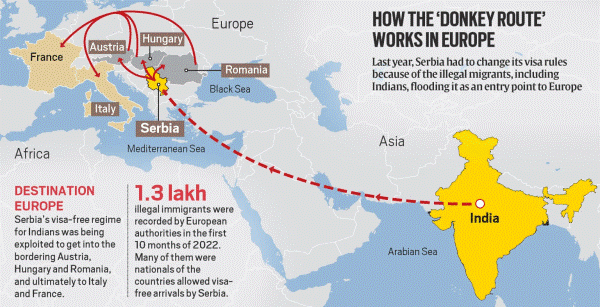Dunki Routes

- 09 Feb 2025
In News:
Recently, a US military aircraft carrying 104 deported Indian nationals landed at Amritsar Airport. These deportees had entered the United States through the illegal “Dunki” route, paying between ?30 lakh and ?1 crore to agents and human traffickers.
Since 2009, over 15,000 Indians have been deported from the US for illegal entry, with India now figuring among the top non-Latin American countries in deportation rankings.
What is the ‘Dunki Route’?
- The “Dunki” or “Donkey” route refers to an unauthorised, arduous journey that migrants undertake through multiple countries to reach destinations like the United States, bypassing legal immigration processes.
- Routes often begin in countries with visa-on-arrival access or easy tourist visa policies for Indians:
- Latin America: Ecuador, Bolivia, Guyana, Brazil, Venezuela
- Europe/Central Asia: Azerbaijan, Turkey, Kazakhstan
- Southeast Asia: Malaysia (via Bangkok)
- Migrants often transit through Mexico, Guatemala, or Costa Rica before crossing into the US through illegal land borders.
How the Network Operates:
- Human trafficking syndicates use fake or manipulated visas (e.g., Schengen visas) to move migrants across Europe, Central Asia, and Latin America.
- Indian passport holders are sent to countries with lenient visa regimes, followed by overland or sea routes to US borders.
- Delhi Police (IGI unit) revealed that many migrants travel to Turkey or Kazakhstan and then cross to Russia or Latin America before attempting US entry.
Reasons Behind Illegal Migration:
- Economic Opportunities: Low wages in India drive migration to higher-paying economies.
- Limited Legal Avenues: Long, uncertain visa approval processes discourage legal pathways.
- Cultural Pressures: In communities like the Patels of Gujarat, migration to the US is tied to social prestige, often compelling families to sell land or take loans.
- Success Stories: Stories of successful illegal migrants inspire others to follow suit.
- Thriving Smuggling Rackets: Demand for migration has led to lucrative smuggling networks.
Consequences and Risks:
- Human Cost: Migrants risk robbery, assault, rape, and death, with bodies often unrecovered.
- Economic Loss: Families face financial ruin due to heavy agent fees.
- Legal Repercussions: Deportation, detention, and blacklisting from future visas.
- Geopolitical Sensitivity: Damages bilateral ties with countries like the US and strains consular systems.
Government Response and Policy Measures:
Proposed Legislation:
- India is considering the Overseas Mobility (Facilitation and Welfare) Bill, 2024 to:
- Promote safe, orderly, and regular migration
- Replace the outdated Emigration Act, 1983
- Establish comprehensive mechanisms for migrant protection and regulation
Awareness Campaigns:
- Indian embassies and consulates regularly issue:
- Advisories on fraudulent agents
- Guidance on safe migration
- Lists of registered recruiting agencies
Migration Trends and Global Standing:
- World Migration Report 2024 (IOM):
- India received $111 billion in remittances in 2022 – highest globally
- India is the largest country of origin for international migrants, with large diasporas in the UAE, US, and Saudi Arabia
H-1B Visa: The Legal Face of Indian Migration to the US
- H-1B Program: Allows US employers to hire foreign workers in high-skill occupations requiring at least a bachelor’s degree.
- Duration: Maximum of six years, renewable under certain conditions, or convertible into a Green Card.
- Indian Dominance:
- Indians have accounted for over 70% of all H-1B visa approvals since 2015
- Chinese applicants make up the second-largest group (~12–13%)
Political Challenges:
- Immigration, including H-1B, is a polarising issue in US politics.
- Rising anti-immigration sentiment, especially under administrations like Trump 2.0, affects policy and visa quotas.
Hotspot States and Migration Routes in India:
- Major source states of illegal migrants: Gujarat, Punjab, Haryana
- These regions are hubs for agents who facilitate illegal migration using Dunki routes and exploit aspirational youth.
